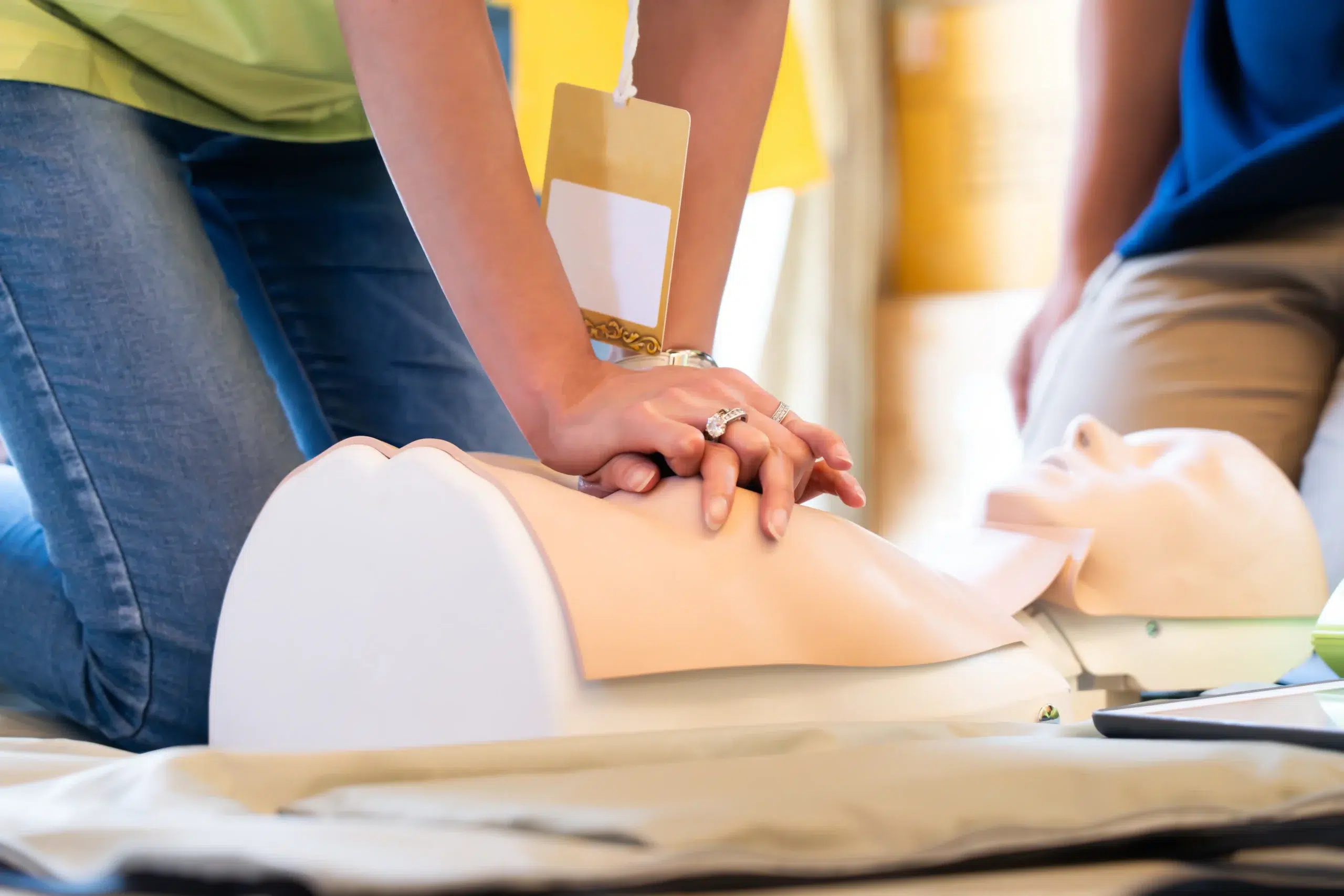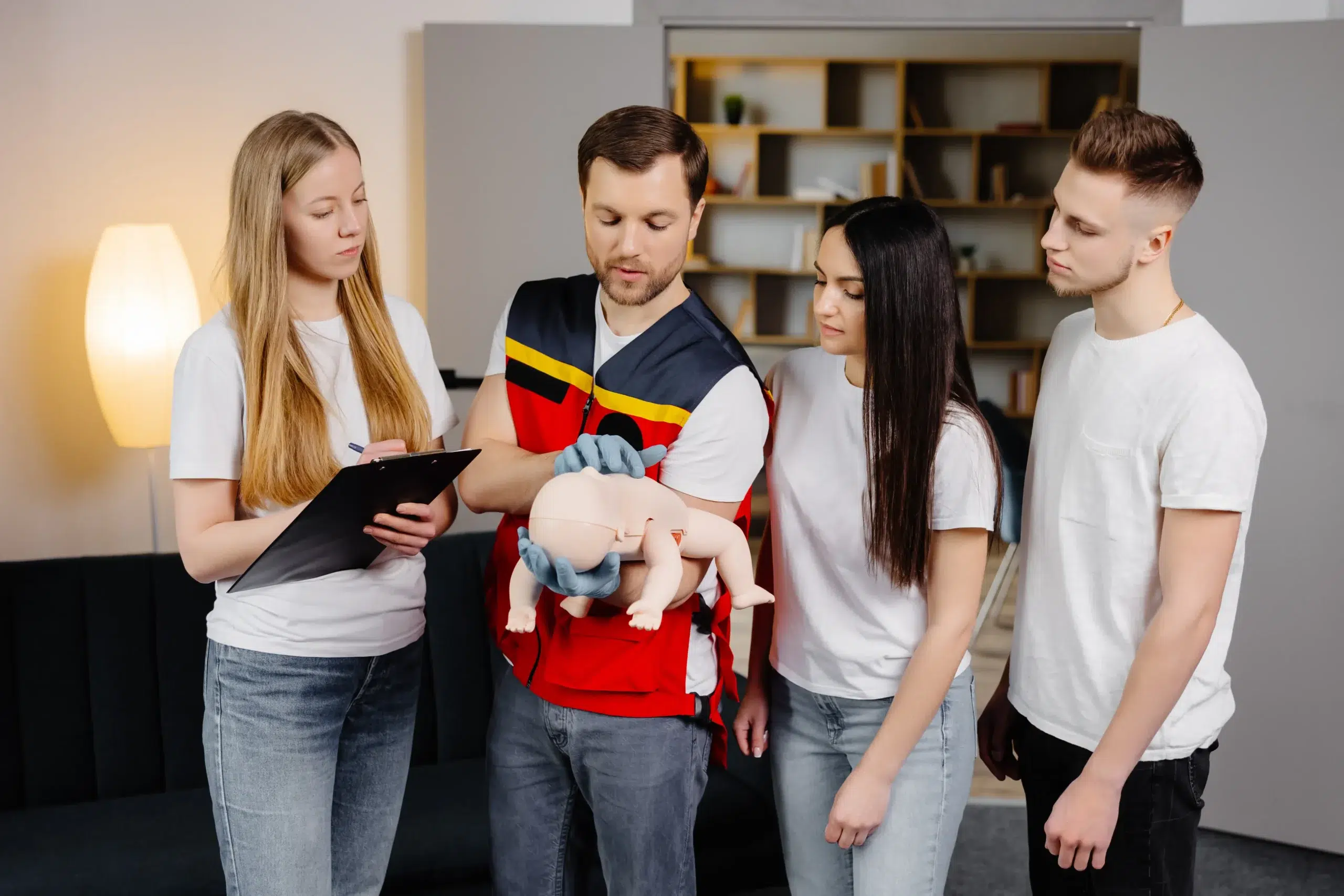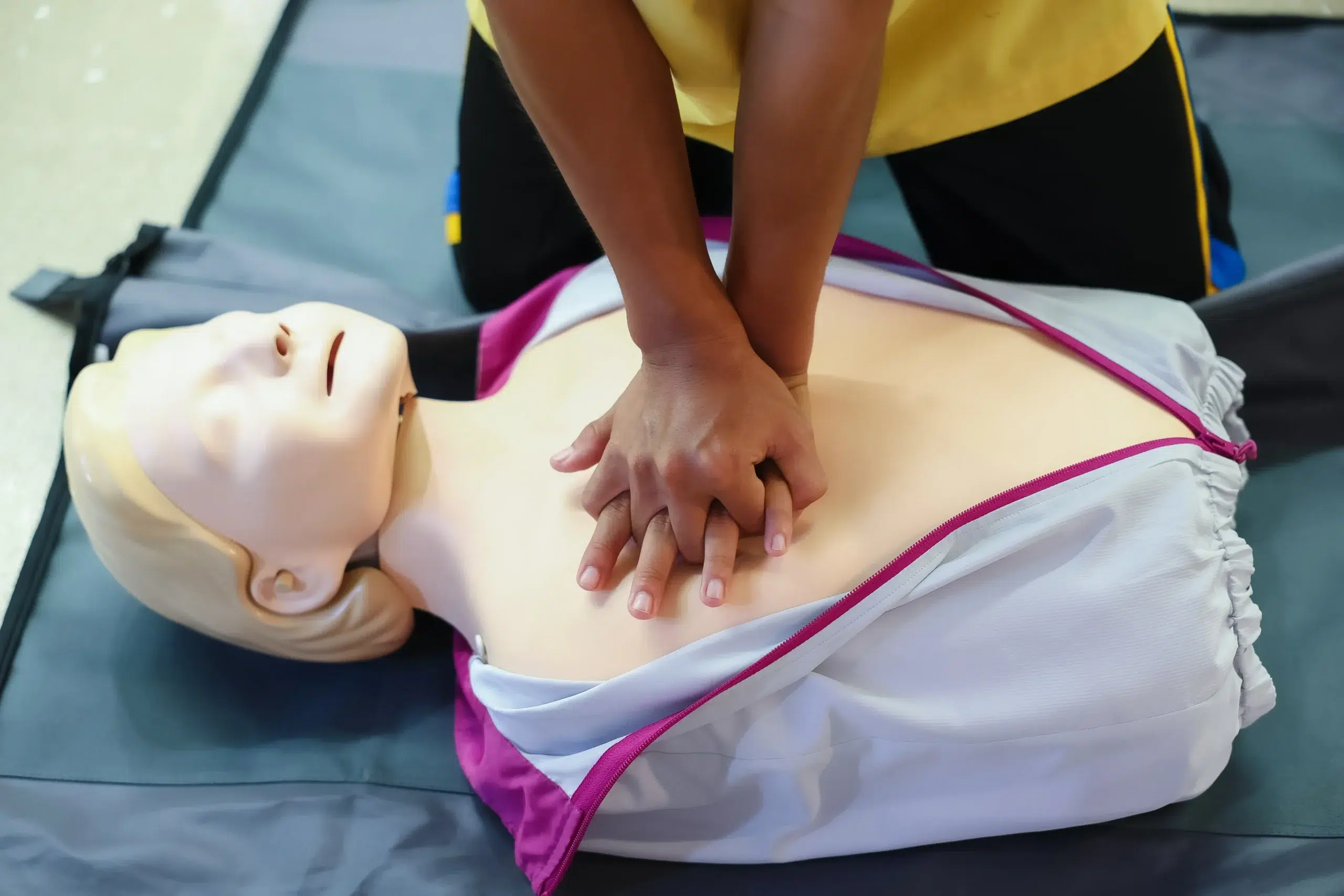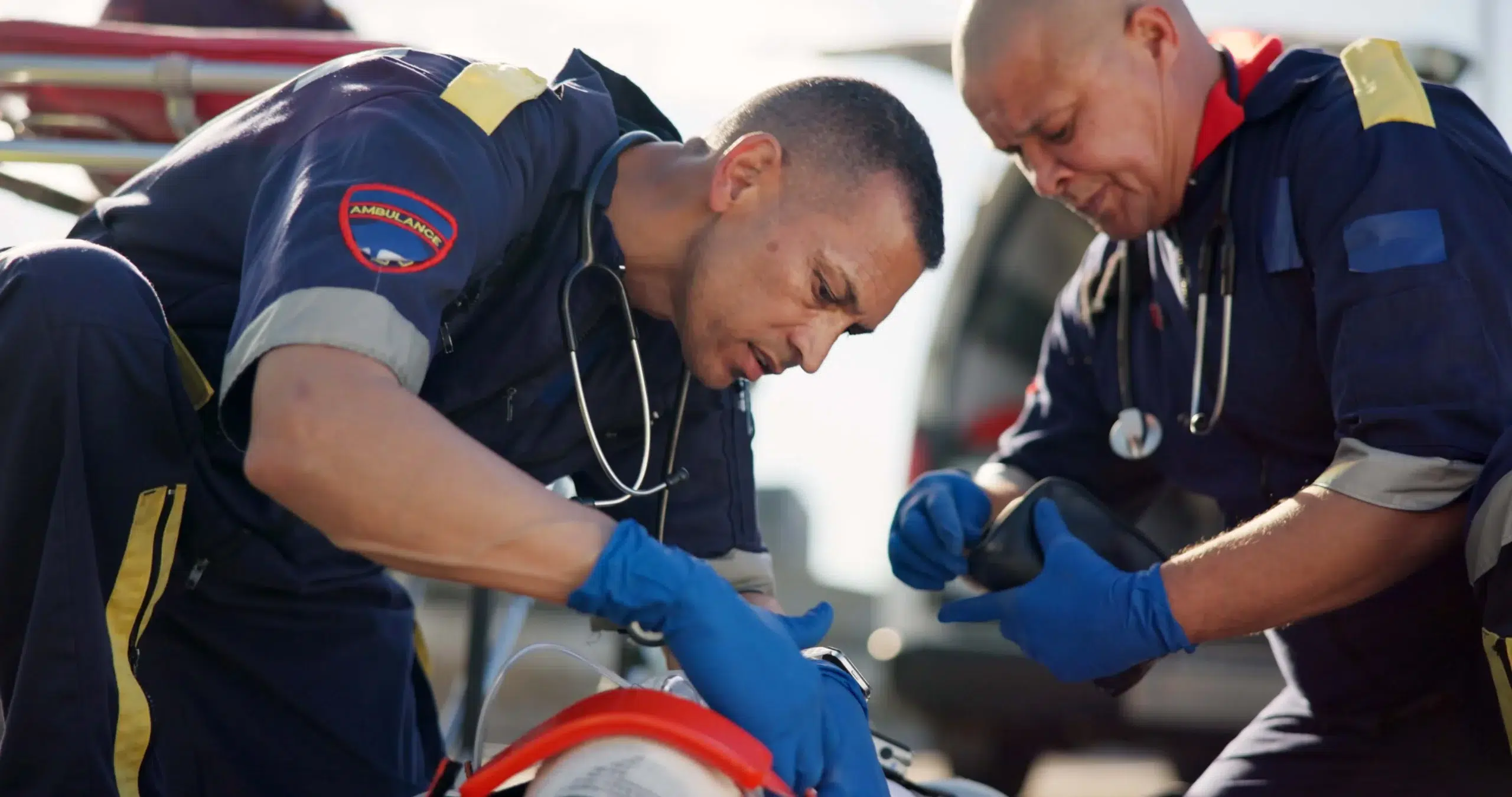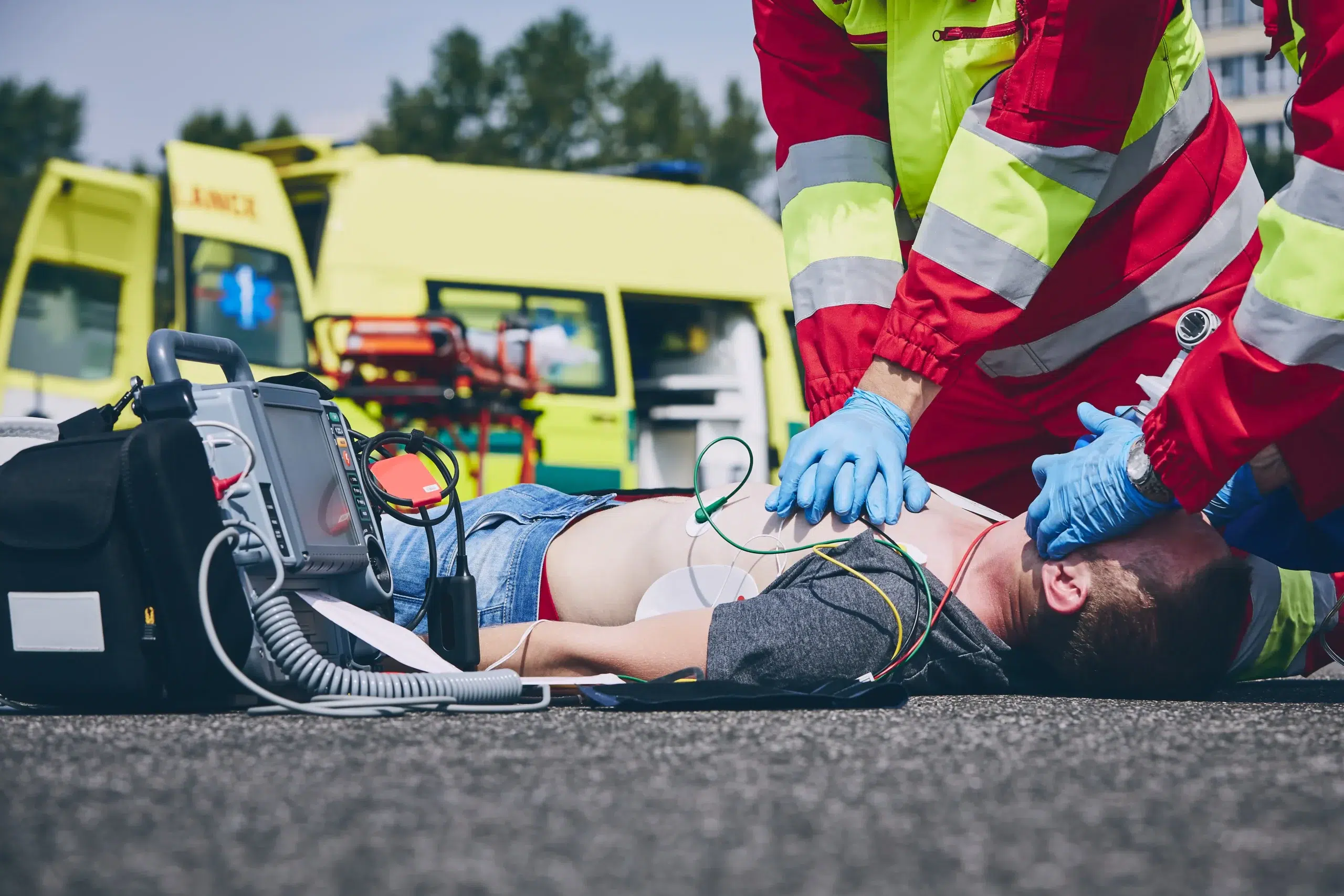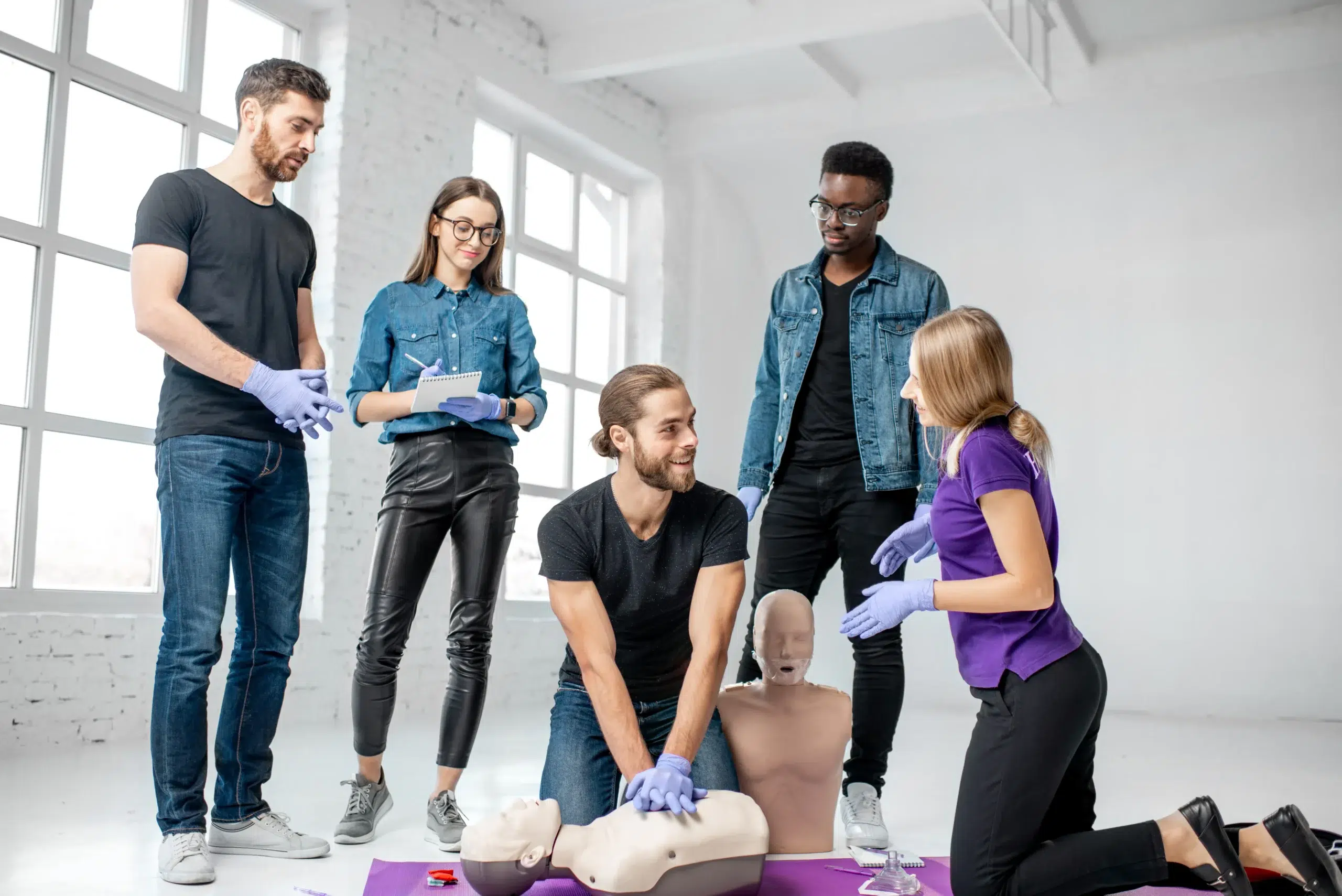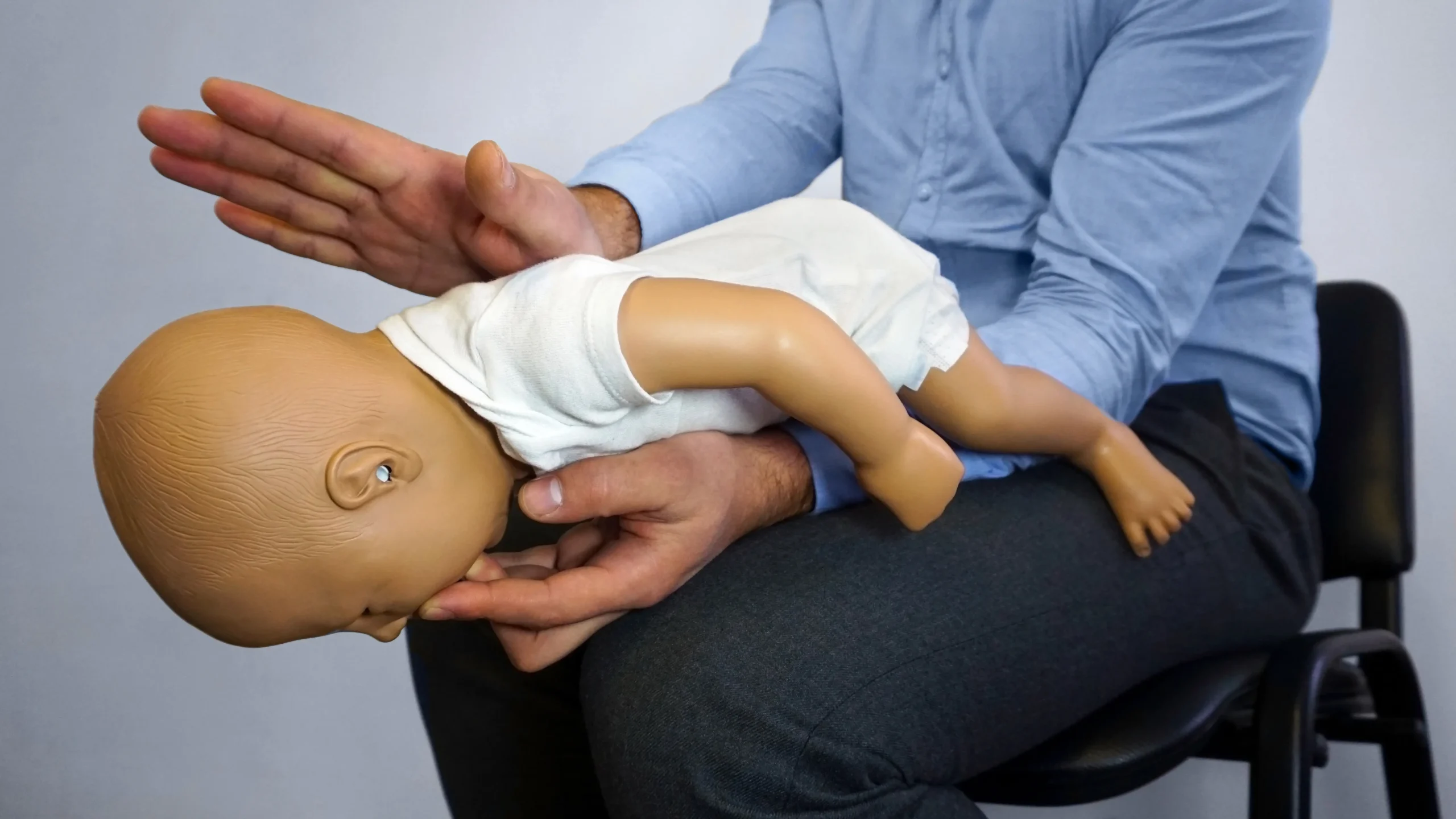Accidents can happen in the blink of an eye, especially with children. Knowing how to respond quickly and effectively in a medical emergency can be the difference between a positive outcome and a tragedy. This guide focuses on pediatric CPR and first-aid training in Newark, providing valuable information for parents, caregivers, and anyone working with children. We’ll cover the importance of these skills, the differences between adult and pediatric CPR, and how to find the right training course in Newark. We’ll also address common misconceptions about CPR and first aid and discuss the life-saving potential of these essential skills. If you’re searching for pediatric CPR and first-aid in Newark, this guide will help you get started.
Key Takeaways
- Pediatric CPR and first aid equip you to handle emergencies involving children. These skills are invaluable for parents, caregivers, teachers, and anyone regularly interacting with children. Seek out a reputable training provider offering certification from a recognized organization like the American Heart Association or the Red Cross.
- Finding the right course involves considering your learning style and schedule. In-person classes provide hands-on practice and direct feedback, while online options offer flexibility. Hybrid courses combine the benefits of both. Consider factors like course content, cost, and instructor qualifications when making your decision.
- Preparing for your course sets you up for success. Bring essential materials like a notebook and pen, dress comfortably, and arrive ready to actively participate. Mentally prepare yourself to engage with the material and ask questions. Remember, your proactive approach to learning these skills can significantly impact a child’s safety.
What is Pediatric CPR and First Aid?
Pediatric CPR and First Aid training gives anyone caring for children—parents, babysitters, teachers, and other caregivers—the skills to respond to breathing and cardiac emergencies in infants and children. Knowing how to perform pediatric CPR can make a profound difference in the outcome of such emergencies.
How Pediatric CPR Differs from Adult CPR
Pediatric CPR differs from adult CPR in several key ways. Infants and children have smaller airways and different physiological responses. Pediatric CPR techniques are adapted to accommodate these differences, ensuring effective airway management and circulation. While general CPR training is helpful, specialized courses like Pediatric Advanced Life Support (PALS) certification provide more in-depth knowledge and skills specifically tailored to pediatric emergencies.
Common Misconceptions
One common misconception is that performing CPR incorrectly is more harmful than doing nothing at all. This isn’t true. Even imperfect CPR is better than no CPR. Hesitation due to fear of making a mistake can cost precious time in a critical situation. Another misconception revolves around the perceived difficulty of CPR. Many people believe they won’t be able to remember the steps or perform them correctly under pressure. High-quality CPR training addresses these concerns by providing clear instructions, hands-on practice, and confidence-building exercises. Dispelling these myths is crucial to encouraging more people to learn this life-saving skill.
Why Learn Pediatric CPR and First Aid?
Knowing pediatric CPR and first aid can make all the difference if a child is hurt or sick. It empowers you to respond effectively and potentially save a life. This section explores why these skills are so valuable.
Importance for Parents and Caregivers
As a parent or caregiver, you’re responsible for a child’s safety and well-being. A pediatric first-aid and CPR course equips you with the skills to handle unexpected situations. You’ll learn to recognize choking hazards, administer CPR to infants and children, and provide basic first aid for common injuries. These skills are invaluable for anyone regularly interacting with children, including parents, nannies, daycare providers, and camp counselors. Knowing how to respond in a crisis can bring immense peace of mind. Pediatric first aid training empowers you with the skills to recognize and respond to emergencies when they arise.
Life-Saving Potential
The unfortunate reality is that thousands of children experience cardiac arrest each year. CPR can significantly improve a child’s chances of survival, even tripling their odds of a positive outcome. Many infant fatalities result from airway obstructions and breathing difficulties, highlighting the critical need for infant CPR training. Learning these techniques can give you the confidence to act quickly and decisively in a life-threatening situation, potentially saving a precious life. A Pediatric CPR/AED course covers the latest science and techniques for responding to both breathing and cardiac emergencies in children of all ages.
Find Pediatric CPR and First-Aid Courses in Newark
Finding the right pediatric CPR and first-aid course can feel overwhelming, but it doesn’t have to be. This section breaks down the available course types, providers, formats, and durations to help you make an informed decision.
Available Course Types
Most courses combine pediatric CPR with first-aid training, covering essential skills for responding to emergencies involving infants and children. These courses typically address choking, breathing emergencies, and basic injuries. Some providers may offer separate CPR and first-aid certifications, so check specifics if you only need one or the other. A combined course offers comprehensive training and prepares you for various situations. Safety Training Seminars offers a combined CPR and First-Aid Certification course.
Course Providers
Several organizations offer pediatric CPR and first-aid training in and around Newark. Here are a few options:
Safety Training Seminars
Safety Training Seminars provides American Heart Association courses, including CPR, BLS, ACLS, and PALS, right here in Newark. They also offer the convenience of on-site training, bringing the class to your location. This is especially helpful for group training or if you have scheduling constraints. Check out their website for information on discounted group CPR classes. They also have a low price guarantee.
American Red Cross
The American Red Cross offers various CPR/AED and first-aid courses, including options for adults, children, and infants. They have multiple locations and frequently offer classes, making it relatively easy to find one that fits your schedule. You can find their CPR classes in New Jersey listed on their website.
CPR Newark
CPR Newark focuses specifically on CPR training, including infant CPR. Their specialized approach might be a good fit if your primary goal is CPR certification. They offer infant CPR classes in Newark, NJ.
Brooks CPR
Brooks CPR offers a range of CPR and first-aid certification courses in Newark, NJ. They provide a variety of options to meet different needs and schedules. Learn more about their CPR and First Aid certification.
Course Formats and Duration
Courses are available in various formats to suit your learning style and schedule:
In-Person Training
In-person classes provide hands-on training with certified instructors. This format allows for real-time feedback and practice with mannequins and other equipment. These courses typically lead to a two-year certification that meets OSHA standards.
Online Courses
Online courses offer flexibility for those with busy schedules or limited access to in-person classes. While convenient, keep in mind that online courses typically require a separate in-person skills session for full certification. Free online first aid, CPR, and AED training is available through various providers like FirstAidforFree.com.
Hybrid Options
Some providers offer hybrid courses that combine online learning with in-person skills sessions. This blended approach offers some of the flexibility of online learning while still providing the essential hands-on practice. Brooks CPR, for example, uses SquareSpace Scheduling for online booking.
What to Expect in a Pediatric CPR and First-Aid Course
Knowing what to expect can help you feel prepared and confident going into your pediatric CPR and first-aid training. Here’s a glimpse into a typical class:
Curriculum Overview
Pediatric CPR and first-aid courses cover essential topics, starting with recognizing the signs of a medical emergency in infants and children. You’ll also learn how to assess a situation, call for help, and provide appropriate care until professional responders arrive. Specific skills covered include CPR for infants and children, choking relief techniques, and basic first aid for common injuries like cuts, burns, and allergic reactions. Check out our CPR and first-aid certification courses to learn more.
Hands-On Practice
These courses aren’t just lectures. You’ll get plenty of opportunities to practice your skills in a safe and supportive environment. Hands-on training is crucial for building muscle memory and confidence. Expect to work with realistic mannequins designed for infant and child CPR practice. This allows you to get comfortable performing chest compressions, rescue breaths, and other techniques.
Scenario-Based Learning
Beyond practicing individual skills, you’ll also participate in scenario-based learning. This involves working through simulated emergency situations to apply what you’ve learned. These scenarios help you develop critical thinking skills and learn how to respond effectively under pressure. Scenario-based training also helps you adapt your skills to different situations.
Using Training Equipment
Your course will incorporate various training equipment to enhance the learning experience. You’ll work with infant and child CPR mannequins, AED training devices, and other first-aid supplies. Familiarizing yourself with this equipment during training ensures you’ll be better prepared to use it in a real emergency.
Certification and Validity
Knowing how your certification works and how long it’s valid is a key part of your training journey. Here’s a breakdown of what you need to know about certification for CPR and first-aid courses:
American Heart Association Certification
The American Heart Association (AHA) offers a widely recognized certification for CPR and first-aid training. Courses like the Pediatric CPR/AED + First Aid class typically run for about eight hours, giving you plenty of time for hands-on practice and testing. Earning your AHA certification shows your commitment to safety and is generally valid for two years. Safety Training Seminars is a woman-owned AHA Training Center offering these valuable certifications in Newark, CA. They also offer a low price guarantee.
Red Cross Certification
The American Red Cross also provides a well-respected certification for CPR and first aid. Their Adult and Pediatric CPR/AED course covers essential life-saving skills for both age groups, keeping you prepared for a range of emergencies. Like the AHA certification, Red Cross certification is typically valid for two years upon successful completion of the course.
Renewing Your Certification
Even if your certification has expired, remember that attempting CPR in an emergency is always better than doing nothing. However, keeping your skills and knowledge fresh is crucial. The Red Cross advises that skills can decline even within months of training, so renewing your CPR certification every two years is the best way to stay prepared and confident in your abilities. Check with your certifying organization, whether it’s the AHA or Red Cross, for their specific renewal process and requirements. You can find a variety of CPR courses, including BLS courses in Newark, at Safety Training Seminars.
Cost and Financial Considerations
Knowing the costs associated with Pediatric CPR and First Aid certification will help you budget accordingly. Several factors influence pricing, so understanding these can help you find the best fit for your needs.
Price Ranges
Generally, combined Pediatric CPR/AED and First Aid classes cost a bit more than CPR-only courses due to the additional material covered. Expect an eight-hour course, which provides ample time for skills practice and testing, to be in a higher price bracket. A shorter, two-hour CPR and AED course might average around $35 per person, while a more comprehensive pediatric course including First Aid will likely be more. Remember, the goal is to master these life-saving skills, so prioritize thorough training. You can explore our CPR and First Aid certification courses for more details.
Group Discounts and Special Offers
If you’re training with a group, such as coworkers, a parents’ group, or a team of coaches, inquire about group discounts. Many providers, including Safety Training Seminars, offer reduced rates for group bookings. This can be a great way to make the training more affordable while learning alongside friends or colleagues. Visit our site for more information on CPR discounts for groups. We’re committed to making these essential skills accessible to everyone.
Financial Assistance
While less common for basic CPR and First Aid certification, some organizations may offer financial assistance programs or scholarships. It’s always worth checking with your chosen training center. Some employers may cover the cost of training for their employees, recognizing the value of having certified personnel. Safety Training Seminars offers a low price guarantee to ensure our courses are accessible. We also offer a variety of courses, including BLS courses in Newark and information on RQI classes.
Choose the Right Course
Finding the right pediatric CPR and first-aid course takes a little research, but it’s worth the effort. Choosing wisely means you’ll be prepared to confidently handle emergencies involving children.
Factors to Consider
Several factors come into play when selecting a course. First, who are you planning to use this training for? Parents, teachers working with young children, and childcare providers may have different needs. For example, infant CPR classes focus on techniques for babies and toddlers, like recognizing choking hazards and performing chest compressions appropriate for their small size. Standard pediatric CPR and first-aid courses usually cover a broader age range, from infants to adolescents. Make sure the course covers CPR, AED use, and rescue breathing techniques.
Think, too, about how you like to learn. Do you prefer hands-on, in-person training, the flexibility of online modules, or a combination of the two? In-person classes offer direct feedback from instructors and the chance to practice on mannequins. These courses typically result in a two-year certification meeting OSHA standards. Online courses offer convenience, letting you learn at your own pace, but may require supplemental in-person practice.
Finally, check the certification. Make sure the course offers a recognized certification, such as one from the American Heart Association or the American Red Cross.
Comparing Providers
Once you know what you need, research different course providers in your area. Several organizations offer pediatric CPR and first-aid training, each with its own advantages.
Safety Training Seminars in Newark, CA, is a woman-owned AHA Training Center offering American Heart Association-certified courses, including BLS, ACLS, PALS, CPR, and first aid. They offer a low price guarantee and are known for their accessible approach. For other options, Brooks CPR offers various CPR and first-aid certifications, including BLS, ACLS, PALS, and Heartsaver courses. The American Red Cross provides comprehensive CPR/AED training that includes the latest science and techniques for responding to breathing and cardiac emergencies for all ages. CPR Newark offers specialized courses like infant CPR. Compare course content, cost, schedules, and instructor qualifications to find the best fit. Reading reviews and testimonials can also give you a sense of other students’ experiences.
Benefits of Training
Knowing how to respond to a medical emergency can make all the difference. Pediatric CPR and First Aid training empowers you with the skills and confidence to act quickly and effectively when a child’s safety is at risk. Let’s explore some key advantages of becoming trained:
Confidence in Emergencies
Emergencies are stressful. It’s natural to feel overwhelmed or unsure of yourself when faced with a crisis, especially when a child is involved. But having the right training can change that. Pediatric CPR and First Aid certification courses equip you with the knowledge and practical skills to assess the situation, make informed decisions, and take appropriate action. This preparation builds confidence, allowing you to remain calm and focused under pressure. Instead of feeling helpless, you’ll be empowered to provide immediate care, potentially minimizing harm and improving the outcome for the child. This confidence extends beyond the classroom, giving you a sense of security in your daily life knowing you’re prepared for the unexpected. For more information, check out the National Safety Council’s resources on pediatric first aid.
Improved Child Safety
Sadly, accidents happen, and children are particularly vulnerable. From choking hazards to sudden illnesses, the unexpected can occur at any time. Pediatric First Aid training covers a wide range of situations, teaching you how to respond to common childhood injuries and illnesses. You’ll learn how to address cuts, burns, allergic reactions, and other urgent situations. Infant CPR is especially critical, as airway obstructions and breathing difficulties are a significant concern. By knowing how to perform CPR and provide basic life support, you can significantly increase a child’s chances of survival. These skills are invaluable for parents, caregivers, teachers, and anyone who regularly interacts with children, creating a safer environment for the little ones in our lives. CPR Certification Newark offers helpful information on the importance of infant CPR.
Participant Experiences and Reviews
Sharing experiences and reading reviews can be incredibly helpful when choosing a CPR class. It gives you a feel for what to expect and helps you find the right fit, especially when it comes to something as important as pediatric CPR and first aid.
Testimonials
Here are a few examples of what past participants have said about these types of training:
“As a new parent, this class gave me the confidence to handle emergencies. The instructor was fantastic, and the hands-on practice made all the difference.” – Sarah M.
“I recertified my CPR and first aid with a local training center. The instructor was knowledgeable and kept the class engaging. I highly recommend checking them out!” – John D.
“The class was well-structured and easy to follow. I appreciated the small class size, which allowed for personalized attention.” – Maria S.
These are just a few examples, and experiences can vary. Reading reviews on sites like Yelp or Google can provide more insights. You can also check out testimonials directly on the websites of training providers like Safety Training Seminars. Look for comments that resonate with you and address any specific concerns you might have. Reading reviews from other parents or caregivers can be particularly helpful.
Instructor Feedback
Positive instructor feedback is a strong indicator of a quality training program. Look for comments about instructors who are:
- Knowledgeable and experienced: Instructors should have a deep understanding of pediatric CPR and first aid and be able to answer your questions thoroughly.
- Engaging and supportive: A good instructor creates a comfortable learning environment and encourages participation, which is key when learning these essential skills.
- Clear and concise: Instructions should be easy to understand and follow, even in a stressful situation. This is especially important in a fast-paced course like CPR.
- Patient and adaptable: Instructors should be able to adjust their teaching style to meet the needs of different learners. Everyone learns at their own pace, and a good instructor recognizes this.
Look for phrases like “patient instructor,” “clear explanations,” and “made me feel comfortable” when reading reviews. This type of feedback can give you confidence in the quality of instruction you’ll receive. You can often find instructor bios on training center websites, which can offer additional information about their qualifications and experience. This can be especially helpful if you’re looking for an instructor with specific credentials or a particular teaching style.
Prepare for Your Course
Getting ready for your Pediatric CPR and First Aid class involves more than just signing up. A little preparation goes a long way in ensuring you get the most out of your training.
What to Bring
Packing a few essentials can make your learning experience more comfortable and productive. While your CPR instructor will provide the training equipment, consider bringing a notebook and pen to jot down notes. Dress comfortably—you’ll be moving around and practicing hands-on skills. A water bottle is also a good idea to stay hydrated, especially during longer sessions. As CPR Certification Newark advises, simply register for the CPR and First Aid class and show up ready to learn! Since the Pediatric CPR/AED + First Aid class runs for approximately eight hours, according to ABC Health & Safety Training, be sure to plan accordingly.
Mental Preparation
Equally important is preparing yourself mentally. CPR training equips you with life-saving skills, but it’s essential to understand its scope. Bay Area CPR points out that CPR training is a valuable skill, but it doesn’t replace specialized certifications like PALS for more complex pediatric emergencies. Think of this course as a foundational step towards confidently handling emergencies. The American Red Cross highlights that even a few hours of training can give you the confidence to act in an emergency and potentially save a child’s life. Approach the training with an open mind, be ready to participate actively, and know that you’re gaining invaluable skills.
Related Articles
- Pediatric CPR & First Aid Classes in San Jose – Newark CPR Classes
- Pediatric Advanced Life Support (PALS) in Newark – Newark CPR Classes
- PALS HeartCode Fremont: Your Certification Guide – Newark CPR Classes
- Common CPR Myths Debunked for Better Emergency Response
- Why CPR Is Critical in Saving Lives
Frequently Asked Questions
How does pediatric CPR differ from adult CPR?
Pediatric CPR techniques are modified to accommodate the smaller airways and different physiological responses of infants and children. While the core principles remain the same, the techniques for chest compressions, rescue breaths, and airway management are adapted for smaller bodies. Specialized pediatric training like PALS certification delves deeper into these nuances.
What if I perform CPR incorrectly?
It’s a common fear, but even imperfect CPR is better than none. Hesitation due to fear of mistakes can be more harmful than attempting CPR. Training helps build confidence and competence, but in a real emergency, any attempt to provide CPR can make a difference.
Which CPR certification is best?
Both American Heart Association (AHA) and Red Cross certifications are widely accepted and respected. The key is to choose a course that fits your schedule, learning style, and budget. Both organizations offer high-quality training that meets established standards.
Are online CPR courses sufficient?
Online courses offer flexibility, but most require an in-person skills session for full certification. Hands-on practice is crucial for mastering CPR techniques and gaining confidence. Consider a hybrid course that combines online learning with in-person skills practice.
How much do pediatric CPR and first-aid courses cost?
Costs vary depending on the provider, course format, and location. Group discounts are often available, making training more affordable for families, community groups, or workplaces. Check with various providers for pricing and any special offers they might have.
